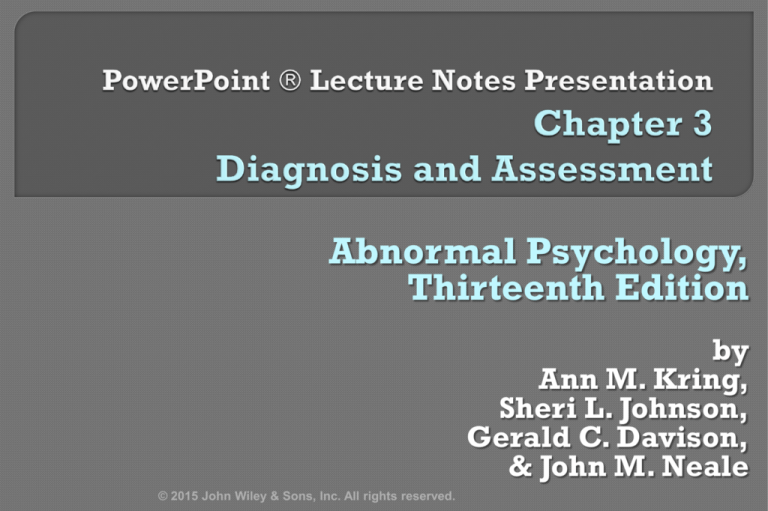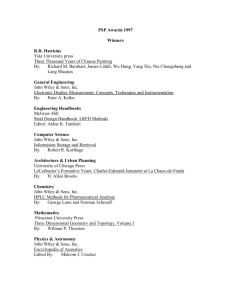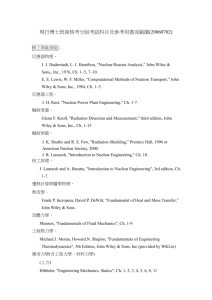
Abnormal Psychology,
Thirteenth Edition
by
Ann M. Kring,
Sheri L. Johnson,
Gerald C. Davison,
& John M. Neale
© 2015 John Wiley & Sons, Inc. All rights reserved.
Chapter
3: Diagnosis and Assessment
I. Cornerstones of Diagnosis and Assessment
II. Classification and Diagnosis
III. Psychological Assessment
IV. Neurobiological Assessment
V. Cultural and Ethnic Diversity and Assessment
© 2015 John Wiley & Sons, Inc. All rights reserved.
Diagnosis
• The classification of disorders by symptoms and
signs.
Advantages
of diagnosis:
• Facilitates communication among professionals
• Advances the search for causes and treatments
• Cornerstone of clinical care
© 2015 John Wiley & Sons, Inc. All rights reserved.
Consistency
of measurement
• Interrater
Observer agreement
• Test-retest
Similarity of scores across repeated test administrations or
observations
• Alternate Forms
Similarity of scores on tests that are similar but not identical
• Internal Consistency
Extent to which test items are related to one another
© 2015 John Wiley & Sons, Inc. All rights reserved.
How well does a test measure what it is supposed to
measure?
Content validity
• Extent to which a measure adequately samples the domain of
interest, e.g., all of the symptoms of a disorder
Criterion validity
• Extent to which a measure is associated with another measure (the
criterion)
Concurrent
Two measures administered at the same point in time
Predictive
Ability of the measure to predict another variable measured at some future point
in time
© 2015 John Wiley & Sons, Inc. All rights reserved.
Construct
validity (Cronbach & Meehl, 1955)
• A construct is an abstract concept or inferred
attribute
• Involves correlating multiple indirect measures of
the attribute
e.g., self-report of anxiety correlated with increased HR,
shallow breathing, racing thoughts
• Important for validating our theoretical
understanding of psychopathology
• Method for evaluating diagnostic categories
© 2015 John Wiley & Sons, Inc. All rights reserved.
Diagnostic
and Statistical Manual
of Mental Disorders (DSM) published by
American Psychiatric Association
• First edition published in 1952
Previous
revised)
edition: DSM-IV-TR (fourth edition,
• Published in 1994, text revised in 2000
• Many texts and research articles will continue to use
DSM-IV terminology for a period of time
Current edition: DSM-5
• Published summer of 2013
© 2015 John Wiley & Sons, Inc. All rights reserved.
© 2015 John Wiley & Sons, Inc. All rights reserved.
© 2015 John Wiley & Sons, Inc. All rights reserved.
Categorical
• Presence/absence of a
disorder
Either you are anxious or you
are not anxious
Dimensional
• Rank on a continuous
quantitative dimension
Degree to which a symptom is
present
How anxious are you on a
scale of 1 to 10?
© 2015 John Wiley & Sons, Inc. All rights reserved.
Changes in multiaxial system
• Five axes in DSM-IV-TR changed to two axes in DSM-5
Clinical Syndromes
Psychosocial and Environmental Problems
Changes in organization of diagnoses
• DSM-IV-TR clusters diagnoses on similarity of
symptoms
• DSM-5 diagnoses are reorganized to reflect new
knowledge of comorbidity and shared etiology
OCD moved from anxiety cluster to new cluster that also
includes hoarding and body dysmorphic disorder
© 2015 John Wiley & Sons, Inc. All rights reserved.
© 2015 John Wiley & Sons, Inc. All rights reserved.
© 2015 John Wiley & Sons, Inc. All rights reserved.
Personality Disorder Diagnoses
• Remain unchanged from DSM-IV
• Proposed revisions included in Section III
For further study
New Diagnoses
• Disruptive mood dysregulation, premenstrual dysphoric
disorder, etc.
Renaming of Diagnoses
• Mental retardation to intellectual disability
• Dysthymia to persistent depressive disorder
Combining Diagnoses
• Substance use disorder replaces substance abuse and
substance dependence, etc.
Clearer
Criteria
© 2015 John Wiley & Sons, Inc. All rights reserved.
Mental
illness universal
Culture can influence:
•
•
•
•
Risk factors
Types of symptoms experienced
Willingness to seek help
Availability of treatments
© 2015 John Wiley & Sons, Inc. All rights reserved.
Cultural
Formulation
9 Concepts of Distress
• Replaces 25 separate diagnoses
• E.g., Amok, Drat, Koru, Taijin kyofusho,
Hikikomori, etc.
Focus
on influence of culture on disorder
presentation
© 2015 John Wiley & Sons, Inc. All rights reserved.
© 2015 John Wiley & Sons, Inc. All rights reserved.
Too
many diagnoses?
• Should relatively common reactions be
pathologized?
• Comorbidity
Presence of a second diagnosis
45% of people diagnosed with one disorder will meet
criteria for a second disorder
Reliability
in everyday practice
© 2015 John Wiley & Sons, Inc. All rights reserved.
© 2015 John Wiley & Sons, Inc. All rights reserved.
Extent
to which
clinicians agree on
the diagnosis
© 2015 John Wiley & Sons, Inc. All rights reserved.
Construct validity of highest concern
Diagnoses are constructs
• For most disorders, no lab test available to diagnose with certainty
Strong construct validity predicts wide range of
characteristics
• Possible etiological causes (past)
• Clinical characteristics (current)
• Predict treatment response (future)
© 2015 John Wiley & Sons, Inc. All rights reserved.
© 2015 John Wiley & Sons, Inc. All rights reserved.
Stigma
against mental illness.
• Treated differently by others
• Difficulty finding a job
Categories
person.
do not capture the uniqueness of a
• The disorder does not define the person.
She is an individual with schizophrenia, not a “schizophrenic”
Classification
may emphasize trivial similarities
• Relevant information may be overlooked.
© 2015 John Wiley & Sons, Inc. All rights reserved.
© 2015 John Wiley & Sons, Inc. All rights reserved.
Techniques
employed to:
• Describe client’s problem
• Determine causes of problem
• Arrive at a diagnosis
• Develop a treatment strategy
• Monitor treatment progress
• Conducting valid research
Ideal
assessment involves multiple measures and
methods
• Interviews, personality inventories, intelligence tests, etc.
© 2015 John Wiley & Sons, Inc. All rights reserved.
Informal/less
structured interviews
• Interviewer attends to how questions are answered
• Is response accompanied by appropriate emotion?
• Does client fail to answer question?
• Good rapport essential to earn trust
• Empathy and accepting attitude necessary
• Reliability lower than for structured interviews
Structured interviews
• All interviewers ask the same questions in a predetermined
order
• Structured Clinical Interview for Axis I of DSM (SCID)
Good interrater reliability for most diagnostic categories
© 2015 John Wiley & Sons, Inc. All rights reserved.
© 2015 John Wiley & Sons, Inc. All rights reserved.
Stress
• Subjective experience of distress in response to
perceived environmental problems
Bedford
College Life Events and Difficulties
Schedule (LEDS)
• Semi-structured interview
• Evaluates stressors within the context of each
individual’s circumstances
Self-Report Stress Checklists
• Faster way to assess stress
• Test-retest reliability low
© 2015 John Wiley & Sons, Inc. All rights reserved.
Personality Tests
• Self-reported Personality Inventories
Minnesota Multiphasic Personality Inventory (MMPI)
Yields profile of psychological functioning
Specific subscales to detect lying and faking “good” or “bad”
• Projective Tests
Rorshach Inkblot Test and Thematic Apperception Test (TAT)
Projective hypothesis
Responses to ambiguous stimuli reflect unconscious processes
© 2015 John Wiley & Sons, Inc. All rights reserved.
© 2015 John Wiley & Sons, Inc. All rights reserved.
© 2015 John Wiley & Sons, Inc. All rights reserved.
Face-to-face
interviews can have low
validity for stigmatized and illegal
behaviors
• E.g., drug use, sexual behavior, violence
• Respondents are more likely to endorse behavior on
a computer questionnaire
© 2015 John Wiley & Sons, Inc. All rights reserved.
Intelligence tests (IQ tests)
• Assess current mental ability
• Wechsler Scales
Wechsler Adult Intelligence Scale, 4th ed. (WAIS-IV)
Wechsler Intelligence Scale for Children, 4th ed. (WISC-IV)
Wechsler Preschool and Primary Scale for Children, 3rd ed. (WPPSI-III)
• Stanford-Binet, 5th ed. (SB5)
• Used to predict school performance, diagnose learning
disabilities or intellectual developmental disorder (mental
retardation), identify gifted children, as part of a
neuropsychological examination
• Mean IQ = 100, SD = 15 (Wechsler) or SD = 16 (SB)
• Lower IQs associated with higher psychopathology and mortality
• Performance on IQ tests impacted by Stereotype Threat
© 2015 John Wiley & Sons, Inc. All rights reserved.
Focus
on aspects of environment
Characteristics of the person
Frequency and form of problematic behaviors
Consequences of problem behaviors
© 2015 John Wiley & Sons, Inc. All rights reserved.
Observe
behavior as it occurs
Sequence of behavior divided into segments
• Antecedents and consequences
Behavioral
assessments often conducted in lab
setting
• e.g., mother and child interact in a lab living room
Interaction observed through one-way mirror or videotaped for
later coding
© 2015 John Wiley & Sons, Inc. All rights reserved.
© 2015 John Wiley & Sons, Inc. All rights reserved.
Self-monitoring
• Individuals observe and record their own behavior
e.g., moods, stressful events, thoughts, etc.
Ecological
Momentary Assessment (EMA)
• Collection of data in real time using diaries or smart
phones
Reactivity
• The act of observing one’s behavior may alter it
Desirable behaviors tend to increase whereas undesirable
behaviors decrease
© 2015 John Wiley & Sons, Inc. All rights reserved.
Use
to help plan treatment targets
Format often similar to personality tests
Dysfunctional Attitude Scale (DAS)
• Identifies maladaptive thought patterns
“People will think less of me if I make mistakes”
© 2015 John Wiley & Sons, Inc. All rights reserved.
© 2015 John Wiley & Sons, Inc. All rights reserved.
© 2015 John Wiley & Sons, Inc. All rights reserved.
Computerized
Axial Tomography (CT or CAT scan)
• Reveals structural abnormalities by detecting
differences in tissue density
e.g., enlarged ventricles
Magnetic
Resonance Imaging (MRI)
• Similar to CT but higher quality
• fMRI (functional MRI)
Images reveal function as well as structure
Measures blood flow in the brain
(BOLD=blood oxygenation level dependent)
Positron
Emission Tomography (PET scan)
• Brain function
© 2015 John Wiley & Sons, Inc. All rights reserved.
© 2015 John Wiley & Sons, Inc. All rights reserved.
Postmortem
studies
Metabolite assays
• Metabolite levels
Byproducts of neurotransmitter breakdown found in
urine, blood serum or cerebral spinal fluid
• May not reflect actual level of neurotransmitter
• Correlational studies
© 2015 John Wiley & Sons, Inc. All rights reserved.
Neuropsychologist
• Studies how brain abnormalities affect thinking,
feeling, and behavior
Neuropsychological Tests
• Reveal performance deficits that can indicate areas of
brain malfunction
• Halstead-Reitan battery
Tactile Performance Test-Time
Tactile Performance Test-Memory
Speech Sounds Perception Test
• Luria-Nebraska battery
Assesses motor skills, tactile and kinesthetic skills, verbal and
spatial skills, expressive and receptive speech, etc.
© 2015 John Wiley & Sons, Inc. All rights reserved.
Psychophysiology
• Study of bodily changes that accompany psychological
characteristics or events
Electrocardiogram
(EKG)
• Heart rate measured by electrodes placed on chest
Electrodermal
responding (skin conductance)
• Sweat-gland activity measured by electrodes placed on
hand
Electroencephalogram
(EEG)
• Brain’s electrical activity measured by electrodes
placed on scalp
© 2015 John Wiley & Sons, Inc. All rights reserved.
© 2015 John Wiley & Sons, Inc. All rights reserved.
Cultural
bias in asessment
• Measures developed for one culture or ethnic group
may not be valid or reliable for another.
• Not simply a matter of language translation
Meaning may be lost
Cultural
bias can lead to minimizing or
exaggerating psychological problems
© 2015 John Wiley & Sons, Inc. All rights reserved.
Increase
graduate students’ sensitivity to
cultural issues
Insure participants’ understanding of task
Establish rapport
Distinguish “cultural responsiveness” from
“cultural stereotyping” (Lopez, 1994)
• Conclusions should be tentative and alternative
hypotheses should be entertained
© 2015 John Wiley & Sons, Inc. All rights reserved.
Copyright 2015 by John Wiley & Sons, Inc. All
rights reserved. No part of the material protected
by this copyright may be reproduced or utilized in
any form or by any means, electronic or
mechanical, including photocopying, recording
or by any information storage and retrieval
system, without written permission of the
copyright owner.
© 2015 John Wiley & Sons, Inc. All rights reserved.








